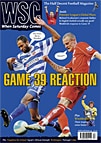 A journeyman pro in his adopted country, Junior Agogo became a star back in Ghana, even getting the better of Didier Drogba – before returning to League One. Chris Taylor reports
A journeyman pro in his adopted country, Junior Agogo became a star back in Ghana, even getting the better of Didier Drogba – before returning to League One. Chris Taylor reports
The host country’s Cup of Nations campaign was looking like it was coming unstuck. It had taken a last-minute goal to overcome Guinea in their first match and now, in their second, Ghana were labouring to make headway against the debutant Namibians, who had been hit for five in their opening encounter against Morocco. But when Quincy Owusu-Abeyie crossed from the right, Ghana’s powerhouse centre-forward was on hand to flick the ball into the net from four yards out. Junior Agogo’s goal proved to be the winner and in that moment he went from the popular spearhead of Ghana’s attack to national hero and sex symbol.
Michael Essien’s face was everywhere in Accra, fronting advertising campaigns for everything from phones to ice cream. Sulley Muntari’s name was sung. But when it came to unbridled adulation, there was no contest: Agogo was the man. The Nottingham Forest fan who wore his Agogo club shirt to Ghana’s matches found he was mobbed by jubilant locals who seemed to seize upon him as the next best thing to the great man himself. One man even turned up at the team hotel offering Agogo his granddaughter as a wife.
All of which might have come as some surprise to supporters of Lincoln, Chesterfield, Chester, Oldham, Sheffield Wednesday, QPR, Bristol Rovers or Barnet, who may have caught sight of the bulky striker on his wanderings around the byways of English football. Manuel “Junior” Agogo is 28 – he moved to Britain as a boy – but he has never played at a level higher than the English third division, unless you count a spell in the United States where he appeared for Chicago Fire, Colorado Rapids and San Jose Earthquakes.
Ivory Coast arrived in Ghana with the African Footballer of the Year leading their attack, a man who had won the Premier League twice with Chelsea and scored the winner in the FA Cup final. Cameroon could call on a Barcelona star with a Champions League winner’s medal. Agogo turned up fresh from a League One fixture against Huddersfield. This made little difference to his legion of admirers, including Ghana’s well travelled French coach, Claude Le Roy, who consistently preferred Agogo to, among others, the pacy Asamoah Gyan, who had been Ghana’s most dangerous attacker at the 2006 World Cup.
But not everybody was so taken with the big man. He may be having a decent season at Forest (11 goals to date), but with his boxer’s build and erratic touch he cut a figure in the Ghana team not unlike that of Serginho, the painfully limited “English-style centre-forward” who somehow claimed a place in Brazil’s exquisite 1982 World Cup side. One pundit on Ghanaian television stated bluntly: “Ghana cannot win the Cup of Nations with Junior Agogo.”
The quarter-final against Nigeria displayed the full range of Agogo’s limitations, with several promising moves turning into lost causes around the forward. But then at 1-1 with ten minutes to go and Ghana a man short after captain John Mensah’s dismissal, Muntari’s break down the left presented Agogo with the ball a yard out. He couldn’t miss (although he nearly did) and Agogomania went into overdrive.
Ghana’s campaign ran aground in the next match, against Cameroon. Samuel Eto’o had had a quiet tournament, despite becoming the top scorer in Cup of Nations history. In the semi‑final, though, he showed the sort of class Ghana might have envied, coming short to thread a perfect first-time ball for Alain Nkong to score the match’s only goal.
The third-place game looked like another mismatch of striking talent. Agogo, though, had the last laugh, coolly slotting home Essien’s incisive pass to score Ghana’s third in a 4-2 victory over Didier Drogba’s Ivory Coast.
Agogo’s African exploits brought rumours of Premier League interest, but for the time being at least the Black Stars’ leading light is back at the City Ground. “In Ghana I can’t do nothing. I can’t go anywhere,” Agogo said. “I have to have security with me everywhere I go. It’s so weird going from that level to coming down here. It’s quite surreal.”
From WSC 254 April 2008